Cold rainy days in the Bay Area call for this flavorful Kimchi Soondubu Jjigae also known as Korean Soft Tofu Stew.

Easily one of my all-time favorite stews is Soondubu Jjigae which is a Korean soft tofu stew. The blend of spices and flavors is incredibly delicious and oh-so-satisfying that my stomach growls when talking about it.
The idea of making this Korean dish at home never once crossed my mind because I could easily order this at a restaurant but, let’s be real, that gets expensive. So, in my quest to save money and expand my cooking repertoire at home, I decided to take up the cooking challenge.
After scouring the web for the perfect recipe that was both easy and tasty, I finally found the right one. With a few adaptations, this Kimchi Soondubu Jjigae recipe comes courtesy of Korean Bapsang.
Special Ingredients
While I’m always a fan of substitutions in a pinch, it’s important to call out the two must-have ingredients when making Soondubu Jjigae:
Gochugaru, a Korean chili powder, is what gives this stew it’s gorgeous vibrant color and smoky flavor. It is quite different from regular chili powder and is a critical item for this recipe. Note: gochugaru burns very easily (I learned the hard way!) so make sure to stir constantly without letting it sit over the heat.
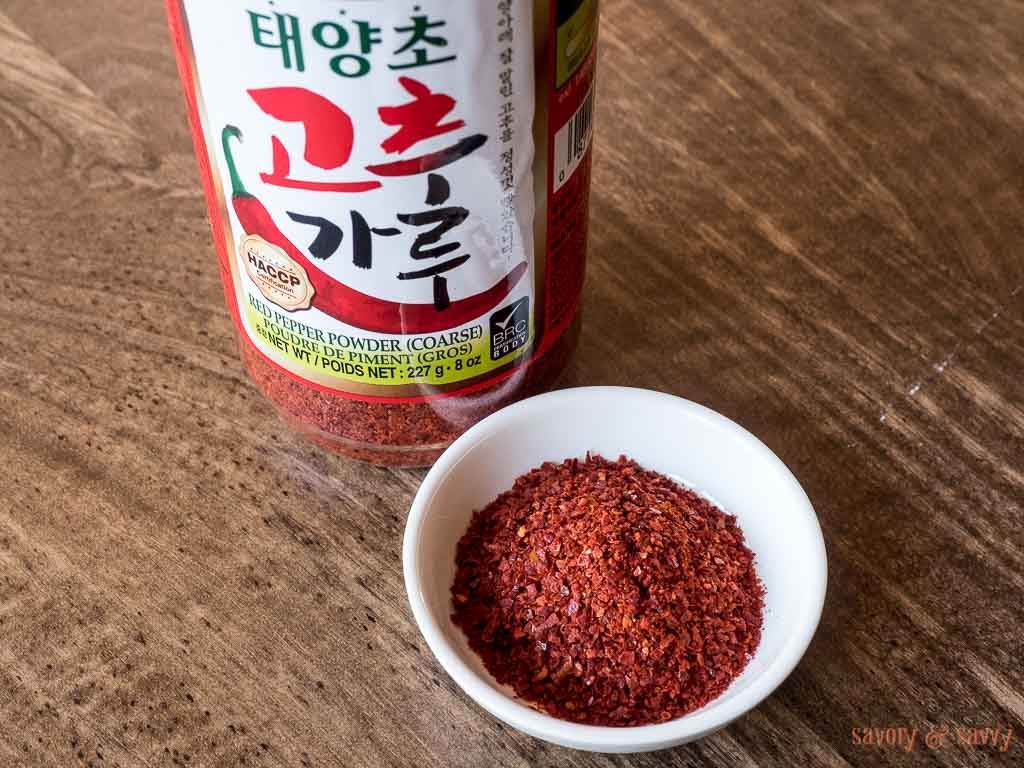
Soondubu is extra silken tofu that has not been pressed or strained which gives it a high water content and a delicate smooth texture that is different from regular soft tofu, believe it or not.
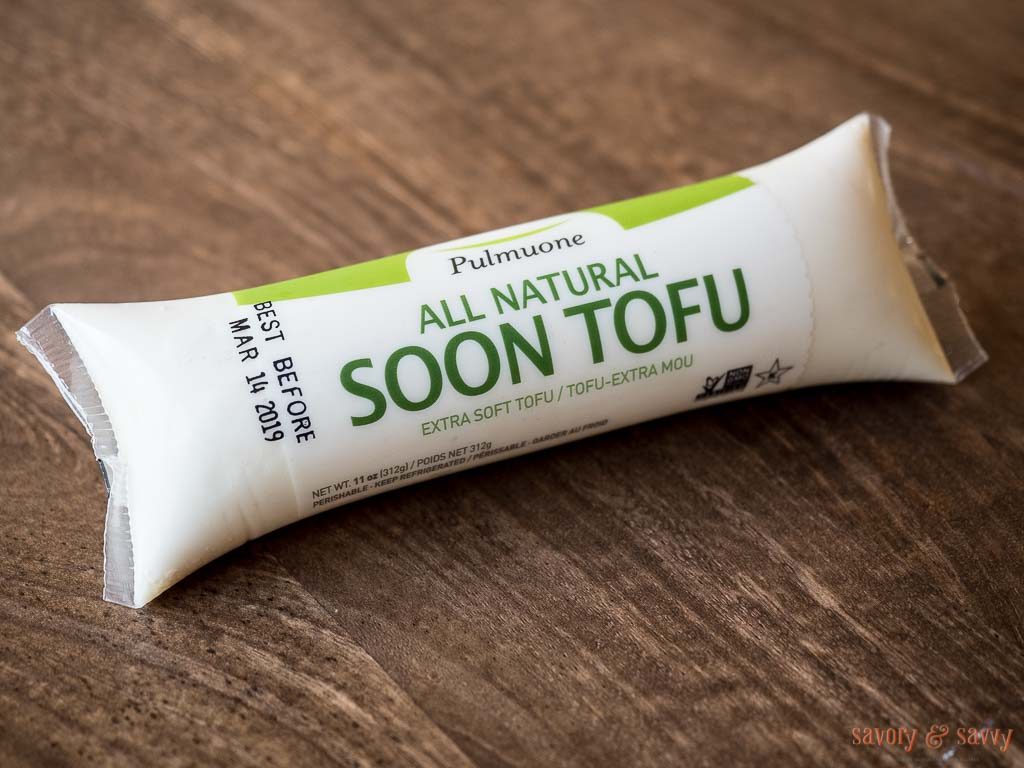
If you are looking for these ingredients, visit your local Korean market and, if you’re in the Bay Area, luckily there are quite a few options fairly close by.
Here are some of my favorite Bay Area Korean grocery stores:
- Koreana Plaza Market in Oakland
- Hankook in Sunnyvale
- First Korean Market in Inner Richmond
Recipe Tips
Here are a few things I learned while making Soondubu Jjigae that are worth noting and sharing:
- When using kimchi, it is preferred to use when it’s especially fermented. It gives it that extra boost of umami. (Fresh kimchi is delicious, too, TBH.) You can also omit the kimchi. It’s not the end of the world but then it’ll simply be called Soondubu Jjigae instead. 🙂
- If you don’t have a soondubu pot, a small saucepan works fine.
- The hero of the dish is soondubu so only a small amount of meat or vegetables is needed for additional seasoning. For this recipe, I used mushrooms and anchovy which really gives it a lot of intense flavor inexpensively but other substitutions also work well. Options include shrimp, clams, mussels, beef, pork, chicken or onion. If you’re looking to keep costs down, stick to mushrooms or inexpensive cuts of meat or seafood.
- The original recipe calls for anchovy stock so if you plan to use that, you can omit the anchovy fillets. If you use neither anchovy or anchovy stock, any good quality stock works perfectly fine but you will likely need to adjust the seasoning at the end.
- This recipe cooks very fast so ensure all your ingredients are prepped and close by before you begin cooking.
Kimchi Soondubu Jjigae really hits the spot any time for me but especially on cold evenings. Since it cooks up quickly, it’s perfect for a weeknight meal or when you’re on the verge of hangry. It’s such a versatile dish that you can easily eat a different kind of Soondubu Jjigae every day of the week. The possibilities are endless! I can’t wait for you to see how easy and delicious it is to cook. Bon Appetit!
Kimchi Soondubu Jjigae (Soft Tofu Stew)
|
|
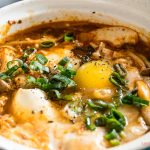
|
- 1 package (12 ounces) soonndubu tofu
- 1/3 cup thinly sliced kimchi
- 1.5 ounces shimeji mushroom, broken up in small clusters
- 1.5 oz enoki mushroom
- 1 tsp gochugaru (Korean red chili pepper flake)
- 1 tsp minced garlic
- 1 tsp sesame oil
- 1 cup water (or broth)
- 2 or 3 Tbsp juice from kimchi
- 3 anchovy fillet, minced
- a pinch black pepper
- 1 stack scallion, finely sliced
- 2 eggs (optional)
- Prepare all your ingredients.
- In small saucepan over medium heat, add sesame oil and anchovy. Saute until anchovy starts to melt about 30 seconds.
- Next add gochugaru, kimchi, mushroom and garlic. Saute until mushroom softens about 5 minutes.
- Pour broth (or water) and kimchi liquid into saucepan and stir combine. Bring to boil and cook for 3-4 minutes more making sure to skim off any residue.
- Carefully add black pepper and the soondubu tofu in 3 large pieces. Cook for another 3-4 minutes and turn off the stove. Adjust seasoning with any additional salt. If you’re adding egg, add it immediately after you turn off the stove.
- Top with scallions right before serving. Eat while hot. Enjoy!
- Prepare all your ingredients.
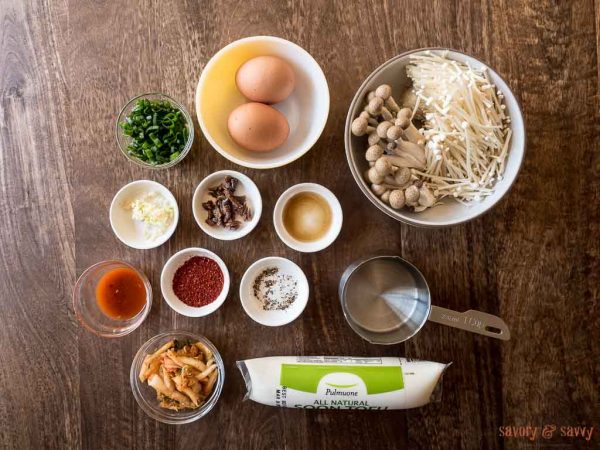
- In small saucepan over medium heat, add sesame oil and anchovy. Saute until anchovy starts to melt about 30 seconds.
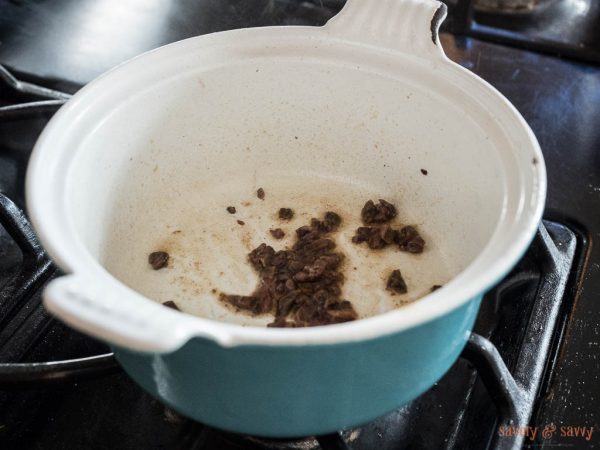
- Next add gochugaru, kimchi, mushroom and garlic. Saute until mushroom softens about 5 minutes.
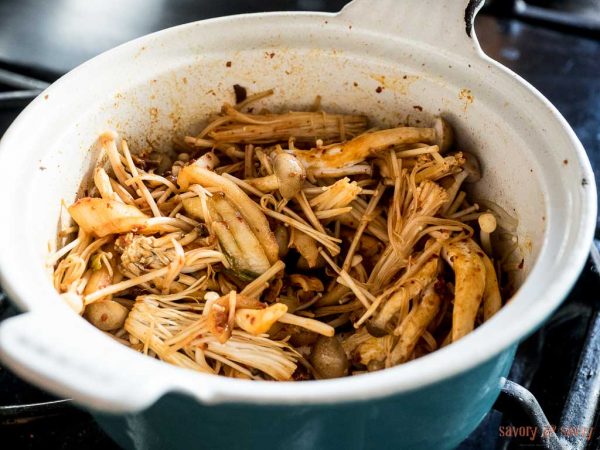
- Pour broth (or water) and kimchi liquid into saucepan and stir combine. Bring to boil and cook for 3-4 minutes more making sure to skim off any residue.
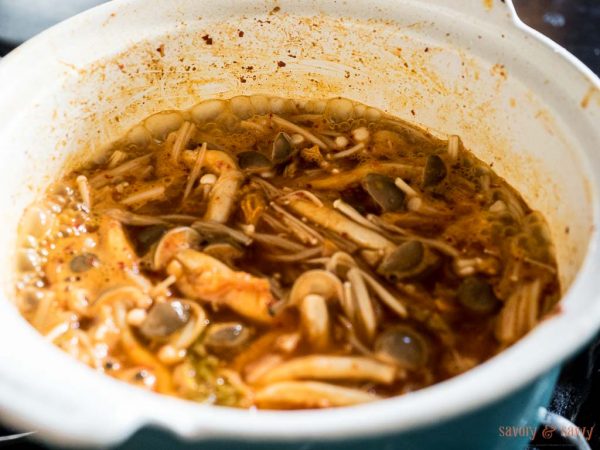
- Carefully add black pepper and the soondubu tofu in 3 large pieces. Cook for another 3-4 minutes and turn off the stove. Adjust seasoning with any additional salt. If you’re adding egg, add it immediately after you turn off the stove.
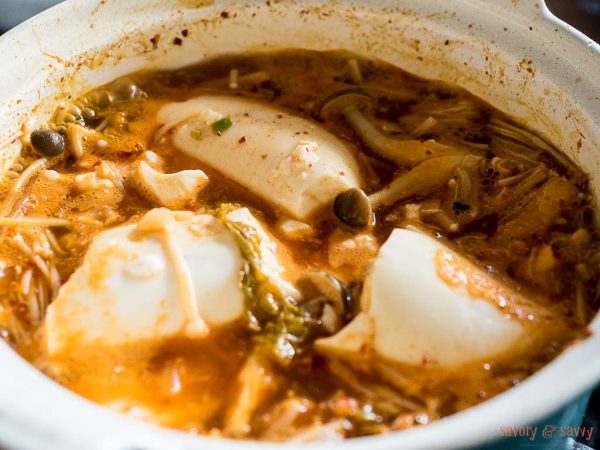
- Top with scallions right before serving. Eat while hot. Enjoy!
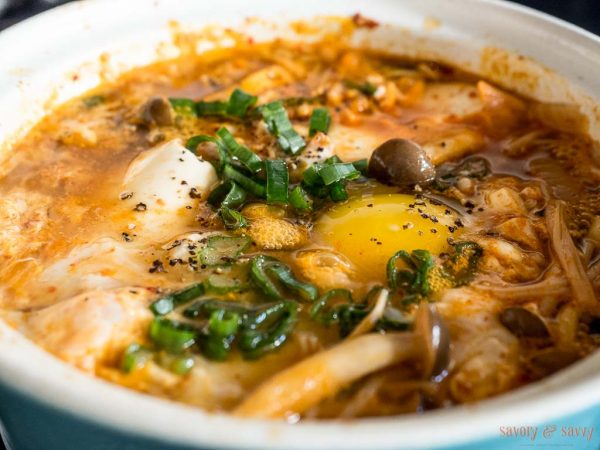
Ingredients | My cost |
|---|---|
| 1 package (12 ounces) sundubu tofu | $0.99 |
| 1/3 cup thinly sliced kimchi | $0.45 |
| 1.5 ounces shimeji mushroom | $1.25 |
| 1.5 oz enoki mushroom | $0.30 |
| 1 tsp gochugaru (Korean red chili pepper powder) | $0.02 |
| 1 tsp minced garlic | $0.09 |
| 1 tsp sesame oil | $0.06 |
| 1 cup water | $0.00 |
| 2 to 3 Tbsp juice from kimchi | $0.00 |
| 3 anchovy fillet, minced | $0.42 |
| pinch black pepper | $0.01 |
| 1 scallion stalk | $0.10 |
| 2 eggs (optional) | $0.58 |
Total: | $4.27 |
| Cost per serving: | $2.19 |
* Note regarding pricing: The lemon and herbs are from our garden which is why there is no cost. The price for items such as salt and pepper take into account the cost of the amount used for the recipe and not the cost if you had to purchase the entire jar or container.
** All prices in US dollars and based on Bay Area prices from my local grocery and farmers market. Prices may vary in other parts of the United States.
Leave a Reply